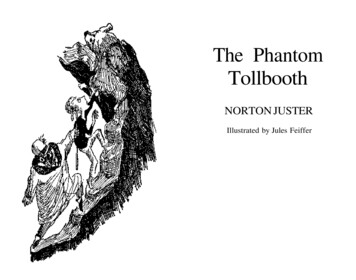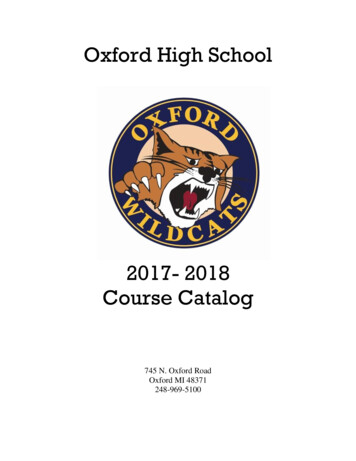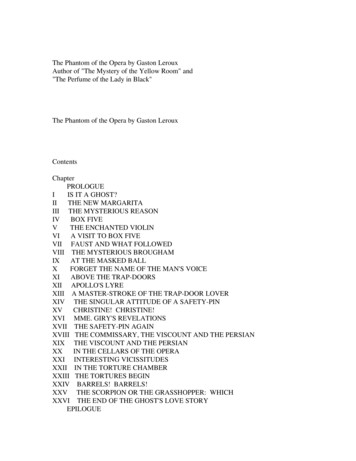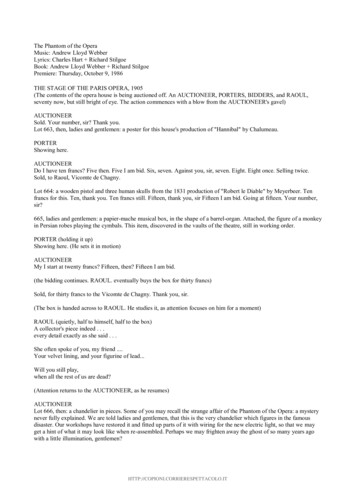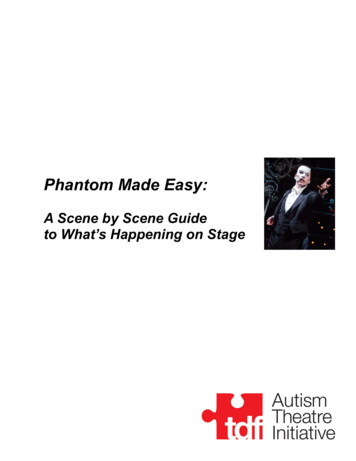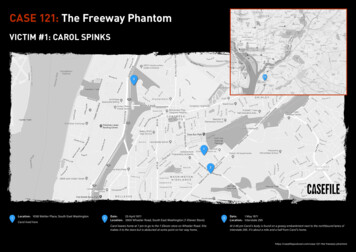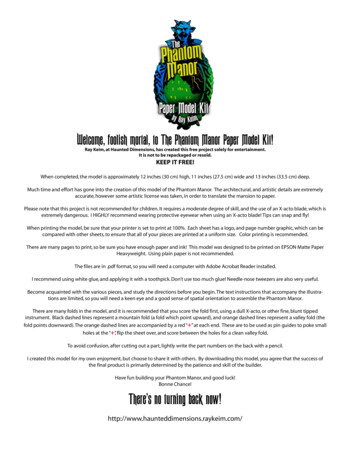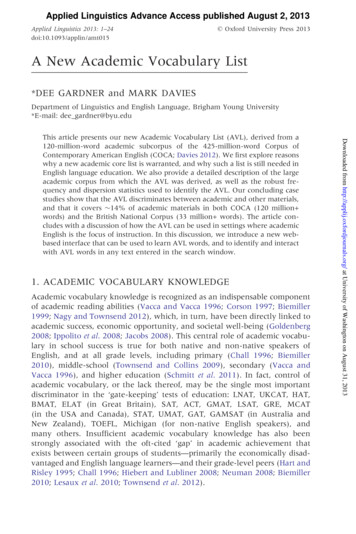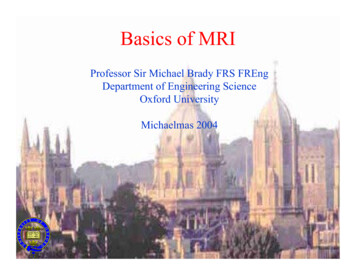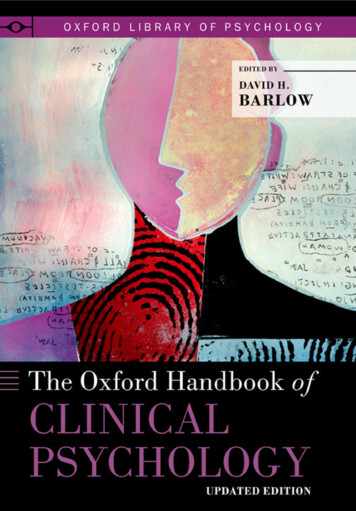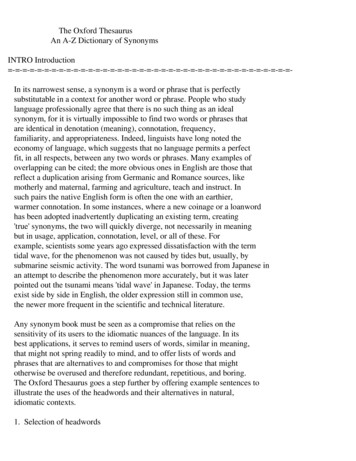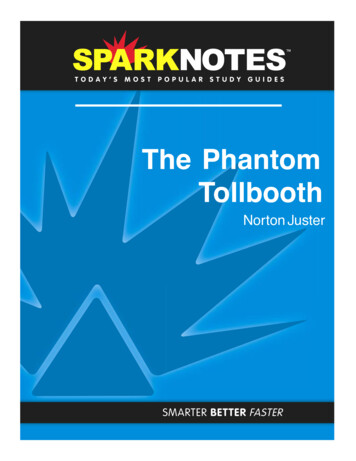
Transcription
4-The PhantomTollboothNorton Juster3-!24%2 "%44%2 &!34%2
Contributors: Brian Phillips, Jeremy Zorn, Julie BlattbergCopyright (c) 2002 by SparkNotes LLCAll rights reserved. No part of this book may be used or reproduced in any manner whatsoever without the written permission of the Publisher.SPARKNOTES is a registered trademark of SparkNotes LLC.This edition published by SparkNotes LLCSparkNotes PublishingA Division of SparkNotes LLC120 5th Ave, 8th FloorNew York, NY 10011
2Stopping to Buy SparkNotes on a Snowy EveningWhose words these are you think you know.Your paper’s due tomorrow, though;We’re glad to see you stopping hereTo get some help before you go.Lost your course? You’ll find it here.Face tests and essays without fear.Between the words, good grades at stake:Get great results throughout the year.Once school bells caused your heart to quakeAs teachers circled each mistake.Use SparkNotes and no longer weep,Ace every single test you take.Yes, books are lovely, dark and deep,But only what you grasp you keep,With hours to go before you sleep,With hours to go before you sleep.Copyright 2002 by SparkNotes LLC.All rights reserved. No part of this publication may be reproduced, transmitted, or distributed in any formor by any means, electronic or mechanical, including photocopy, recording, any file sharing system, orany information storage and retrieval system, without the prior written permission of SparkNotes LLC.
3CONTENTSCONTEXT . . . . . . . . . . . . . . . . . . . . . . . . . . . . . . . . . . . . . . . . . . . . . . . . . . . . . . 4PLOT OVERVIEW . . . . . . . . . . . . . . . . . . . . . . . . . . . . . . . . . . . . . . . . . . . . . . . . 5CHARACTER LIST . . . . . . . . . . . . . . . . . . . . . . . . . . . . . . . . . . . . . . . . . . . . . . . 7ANALYSIS OF MAJOR CHARACTERS . . . . . . . . . . . . . . . . . . . . . . . . . . . . . . 10Milo . . . . . . . . . . . . . . . . . . . . . . . . . . . . . . . . . . . . . . . . . . . . . . . . . . . . . . . . 10Tock . . . . . . . . . . . . . . . . . . . . . . . . . . . . . . . . . . . . . . . . . . . . . . . . . . . . . . . . 11The Humbug . . . . . . . . . . . . . . . . . . . . . . . . . . . . . . . . . . . . . . . . . . . . . . . . . 11THEMES, MOTIFS, AND SYMBOLS . . . . . . . . . . . . . . . . . . . . . . . . . . . . . . . . 12Themes . . . . . . . . . . . . . . . . . . . . . . . . . . . . . . . . . . . . . . . . . . . . . . . . . . . . . 12Motifs . . . . . . . . . . . . . . . . . . . . . . . . . . . . . . . . . . . . . . . . . . . . . . . . . . . . . . . 13Symbols . . . . . . . . . . . . . . . . . . . . . . . . . . . . . . . . . . . . . . . . . . . . . . . . . . . . . 14SUMMARY AND ANALYSIS . . . . . . . . . . . . . . . . . . . . . . . . . . . . . . . . . . . . . . . 15Chapters 1–2 . . . . . . . . . . . . . . . . . . . . . . . . . . . . . . . . . . . . . . . . . . . . . . . . . 15Chapters 3–5 . . . . . . . . . . . . . . . . . . . . . . . . . . . . . . . . . . . . . . . . . . . . . . . . . 17Chapters 6–8 . . . . . . . . . . . . . . . . . . . . . . . . . . . . . . . . . . . . . . . . . . . . . . . . . 19Chapters 9–11 . . . . . . . . . . . . . . . . . . . . . . . . . . . . . . . . . . . . . . . . . . . . . . . . 22Chapters 12–13 . . . . . . . . . . . . . . . . . . . . . . . . . . . . . . . . . . . . . . . . . . . . . . . 25Chapters 14–16 . . . . . . . . . . . . . . . . . . . . . . . . . . . . . . . . . . . . . . . . . . . . . . . 27Chapters 17–18 . . . . . . . . . . . . . . . . . . . . . . . . . . . . . . . . . . . . . . . . . . . . . . . 30Chapters 19–20 . . . . . . . . . . . . . . . . . . . . . . . . . . . . . . . . . . . . . . . . . . . . . . . 32IMPORTANT QUOTATIONS EXPLAINED . . . . . . . . . . . . . . . . . . . . . . . . . . . . 35KEY FACTS . . . . . . . . . . . . . . . . . . . . . . . . . . . . . . . . . . . . . . . . . . . . . . . . . . . . 37STUDY QUESTIONS AND SUGGESTED ESSAY TOPICS . . . . . . . . . . . . . . 40Study Questions . . . . . . . . . . . . . . . . . . . . . . . . . . . . . . . . . . . . . . . . . . . . . . 40Suggested Essay Topics . . . . . . . . . . . . . . . . . . . . . . . . . . . . . . . . . . . . . . . . 41REVIEW AND RESOURCES . . . . . . . . . . . . . . . . . . . . . . . . . . . . . . . . . . . . . . 42Quiz . . . . . . . . . . . . . . . . . . . . . . . . . . . . . . . . . . . . . . . . . . . . . . . . . . . . . . . . 42Copyright 2002 by SparkNotes LLC.All rights reserved. No part of this publication may be reproduced, transmitted, or distributed in any formor by any means, electronic or mechanical, including photocopy, recording, any file sharing system, orany information storage and retrieval system, without the prior written permission of SparkNotes LLC.
4ContextCONTEXTNorton Juster was an architect by training and worked as a professor of design at HampshireCollege in his native England. When he publishedThe Phantom Tollbooth in 1961 it was aninstant classic. Critics in theNew York Times andLife Magazine likened the book to LewisCarroll’s famousAlice in Wonderland, which previously stood alone as the best-knownfantasy novel in the English language.The Phantom Tollbooth is, in a sense, a modern take on Carroll’s famous work, whichwas published in 1865, and an adaptation of some of its key themes. England of the 1960swas in a period of furious progress as a country known for its history pressed toward anuncertain future in the twentieth century. In this time, books of the Victorian era of literaturesuch asAlice in Wonderland began to lose their appeal to younger readers who were alienatedby their older language and dated references.The Phantom Tollbooth gave these readers anopportunity to enjoy a novel of fantasy to which they could more easily relate.The fantasy novel remains an important genre of fiction as it is uniquely well suitedto audiences of all ages. It is often used to teach lessons about life through symbolicinteractions. The best-known examples of this are stories such asGrimm’s Fairy TalesorAesop’s Fables. The fantasy novel is a longer, more refined, and more adult take on thesesorts of stories. The elements of magic help fantasy novels appeal to younger readers whilethe more mature plot construction and language draw in older readers.In writing a modern version of the fantasy novel, Juster attempted to update the themesto make them more pertinent to the twentieth century.The Phantom Tollbooth tackles issuesthat simply did not exist in Carroll’s time. Characters in Juster’s book grapple with issuesrelating to life in cities (such as noise), the boredom bred by instant entertainment, and thelaziness of students in modern schools. At the same time, the book also incorporates someof Carroll’s ideas about creativity and imagination.Juster never wrote another book, butThe Phantom Tollbooth has never gone out of printand remains a favorite among readers of all ages.Copyright 2002 by SparkNotes LLC.All rights reserved. No part of this publication may be reproduced, transmitted, or distributed in any formor by any means, electronic or mechanical, including photocopy, recording, any file sharing system, orany information storage and retrieval system, without the prior written permission of SparkNotes LLC.
5Plot OverviewPLOT OVERVIEWMilo, a very bored little boy, receives an unusual package one day: a make- believe tollbooth.When he drives through it in his electric toy car, he is suddenly transported to the LandsBeyond, a fantastic world of imagination. On his way to Dictionopolis, one of the country’stwo capitals, he meets Tock, the watchdog who joins him on his journey. In Dictionopolis,Milo meets King Azaz who presides over the world of letters and words. Azaz sends Miloon a mission to rescue two princesses, Rhyme and Reason, who are imprisoned in the Castlein the Air, which floats hundreds of feet off the ground. Milo and Tock leave Dictionopoliswith a new companion, the Humbug, whom Azaz has sent along as a guide. The threehead toward Digitopolis where they hope to persuade the Mathemagician to release theprincesses.On their way to Digitopolis, Milo, Tock and the Humbug encounter all sorts of unusualpeople and places. Just outside Dictionopolis they stop at Point of View, where they meetAlec Bings, a little boy who floats above the ground because he has not grown down to ityet. In his family, everyone’s head stays at exactly the same height their entire lives andtheir legs grow down until they touch the earth. The travelers then proceed past the twincities of Reality and Illusions and come upon Chroma and his symphony of color. Milowatches in wonder as Chroma conducts the orchestra through the colors of the sunset and,once Chroma has gone off to bed, decides to try to conduct the sunrise himself. This provesto be more difficult than Milo thought, and soon he has made a complete mess of the colors,which he manages to fix just moments before anyone notices.The exhausted Milo then leads his friends towards the Valley of Sound, where they meetDischord, a fake doctor who deals in noises, and his sidekick Dynne, a monster made ofsmoke. Once the travelers escape the doctor and his horrible racket, they find themselves inthe Valley of Sound, which turns out to be completely silent. They meet the Soundkeeperwho has withheld all the sounds of the Valley because people have stopped appreciatingthem and instead gave business to Dischord and Dynne. Milo steals a sound from theSoundkeeper’s palace, which the people of the valley use to break open the sound vault.After helping save the Valley of Sound, Milo and his friends continue on their way toDigitopolis, taking a short detour to the Island of Conclusions, to which they magicallyjump after making assumptions about their trip. They swim back to shore through the Seaof Knowledge and find themselves on the outskirts of Digitopolis. There they meet theDodecahedron, a man with twelve faces, each of which expresses a different emotion. TheDodecahedron takes the travelers to see the Mathemagician, after giving them a tour throughthe Numbers Mine, where digits are pulled from the earth like jewels. Milo manages totrick the Mathemagician into agreeing to release the princesses and finds out that he mustclimb through the Mountains of Ignorance to reach the Castle in the Air.Copyright 2002 by SparkNotes LLC.All rights reserved. No part of this publication may be reproduced, transmitted, or distributed in any formor by any means, electronic or mechanical, including photocopy, recording, any file sharing system, orany information storage and retrieval system, without the prior written permission of SparkNotes LLC.
6Plot OverviewAlthough they are afraid of the demons they might encounter, Milo, Tock, and theHumbug head into the Mountains of Ignorance. They meet the Everpresent Wordsnatcher,a dirty little bird who twists their sentences into his own meanings, the Terrible Trivium, aman with no features on his face who stalls the travelers with meaningless busywork, and theDemon of Insincerity, who tries to trick them into leaving the path to the castle. Fortunately,Milo has learned a great deal from his travels in the Lands Beyond and manages to escapeeach of these demons and make his way to the unbelievably tall staircase to the Castle in theAir. After climbing to the top, the three travelers encounter a final demon, the Senses Taker,who demands all sorts of trivial information and bogs them down in meaningless questions.Milo’s sense of humor, the one thing the Senses Taker cannot take away, helps him laughhis way past the demon and up to Rhyme and Reason.The two princesses are thrilled to hear that Azaz and the Mathemagician have agreedto release them. Riding on Tock’s back, since time flies, they soar over the Mountains ofIgnorance and land in the midst of a hoard of demons. When it seems that all hope is lost,the Armies of Wisdom, led by Azaz and the Mathemagician, suddenly arrive and drive backthe demons. The two leaders welcome the princesses and begin a celebration to mark theirreturn.Milo himself must also return home and says his goodbyes to all the friends he made inthe Lands Beyond. He returns to his bedroom to find that only a few minutes have passed.The next day, he hurries home from school with dreams of further adventures only to findthe tollbooth gone. All that remains is a note that tells him that he has learned so muchthat he should be able to find his way to all sorts of fantastic lands without the help of thetollbooth. Milo realizes that there are all sorts of fantastic adventures to be had anywhere,even in his own bedroom.Copyright 2002 by SparkNotes LLC.All rights reserved. No part of this publication may be reproduced, transmitted, or distributed in any formor by any means, electronic or mechanical, including photocopy, recording, any file sharing system, orany information storage and retrieval system, without the prior written permission of SparkNotes LLC.
7Character ListCHARACTER LISTMilo—The main character, Milo is a little boy who goes through all of his days in a stateof horrible boredom. This routine changes when Milo takes a trip through the mysteriousmake-believe tollbooth that appears in his bedroom one day.Tock—Milo’s friend Tock is a literally a "watchdog." A giant clock makes up part of hisbody, and he constantly makes ticking noises. He patrols the Doldrums and stops peoplefrom wasting time.The Humbug—The Humbug is an insect who lives only to flatter people—especially him-self. The Humbug is ignorant about everything from math to geography and proves himselfthe fool by his constant attempts to say intelligent things. After trying to brown-nose hisway to favor with King Azaz, he accompanies Milo and Tock on their journey.King Azaz—King Azaz is ruler of the realm of letters and words. Azaz and his brotherargue over which is more important—numbers or letters, and they banish the princessesRhyme and Reason. Once he realizes the foolishness of his squabb
The Phantom Tollbooth is, in a sense, a modern take on Carroll’s famous work, which was published in 1865, and an adaptation of some of its key themes. England of the 1960sFile Size: 1MBPage Count: 49
